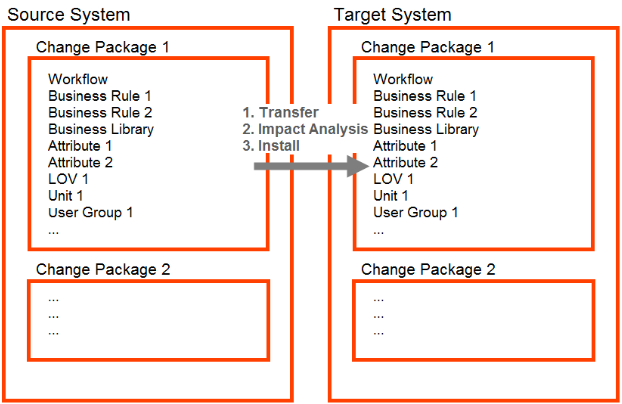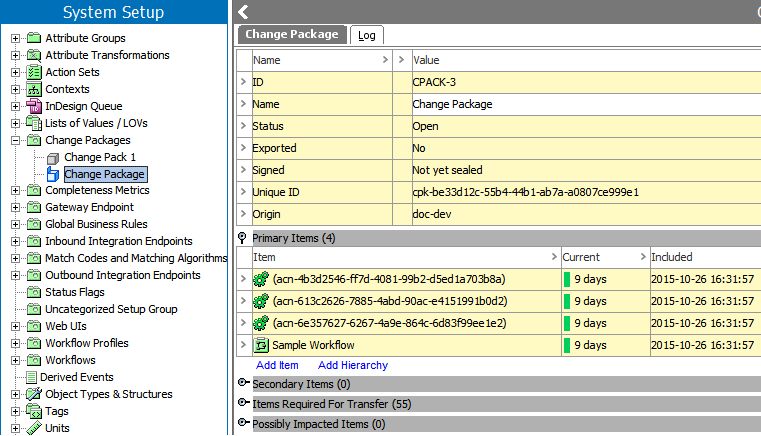A change package allows for an easy way to prepare, process and migrate STEP configuration changes between systems in a larger system landscape. Change packages are designed to:
- Minimize offline tracking of configuration changes
- Lessen the chance for introducing faulty configuration changes
- Assist system administrators with impact analysis to enable more informed decision making
The overall flow of change packages is shown below:

Once created, a user may add or remove items from the package until they are satisfied with the contents. The change package can then be sealed and exported for loading to another system. Upon loading of the change package to the target system, an impact report can be run that helps identify areas that may need to be updated prior to installation and could be impacted upon installation. This provides an indication to the user of how successful the change package will be if applied. The user may then choose to remove or install the change package. If installed successfully, the configurations contained in the change package will be loaded to the system and available for immediate use.
Change Package Objects
Change packages are system setup objects that act as containers to house a set of configurations.

Note: Change packages can include the following STEP objects: Action sets, Asset Importer, Attributes, Attribute groups, Attribute transformations, Business Rules, Classification Product Link Types, Completeness Metric, Contexts, D&B, Dimensions, Dimension Points, Derived Events, Event processors, Event Queues, Gateway Endpoints, Integration endpoints, Link Types, List of Values, Match Codes, Matching Algorithms, Object Types and Structures, PIM Tables, Reference Types, Setup Entities, Setup Groups, Status Flags, Sufficiency configurations, Unique keys, Units, Unit groups, Users and User Groups, Web UI configurations, Workflows, and XSLT Style sheets.
Change Package Icons and Statuses
|
Icon |
Status |
Description |
|---|---|---|
|
|
Open |
|
|
|
Sealed |
|
|
|
Dormant |
|
Change Package Tab
|
Flipper |
Description |
|---|---|
|
Provides basic information about the change package, including the Status, whether or not the change package has been exported, whether or not the package has been sealed, and where the package is originally from (e.g., created on the current system or imported from another system). If the package has been sealed or an impact report has been run on the package, additional fields will be present with links to these processes. |
|
|
Primary Items |
Displays a list of objects that have been directly added to the change packages, as well as providing the interface for adding and removing items from the change package. Users can select to add a single object (Add Item), or an object and all of its child objects (Add Hierarchy). Items in this list are part of the change package and will be created and/or updated on the target system when the change package is installed. |
|
Secondary Items |
System generated list of objects that are part of the change package due to the addition of a parent using the Add Hierarchy option. This list can only be edited by adding or removing the driving primary item. Items in this list are part of the change package and will be created and/or updated on the target system when the change package is installed. |
|
Items Required For Transfer |
System generated list of objects that are required for the change package due to interactions with the selected objects. This list can only be edited by adding or removing the driving primary item. These objects are essentially prerequisites for the transfer as the selected primary objects and/or the secondary objects have some dependency on them. The objects are included in the change package as a means of ensuring that the primary and secondary items are successfully transferred, and will be created and/or updated on the target system when the change package is installed. |
|
Possibly Impacted Items |
System generated list of items that might be affected by the transfer of the change package on the new system. This list can only be edited by adding or removing the driving primary item. These objects are dependent in some way on the primary or secondary object, but are not required for configuration of those objects and are therefore not included in the change package. They will only be modified if they already exist on the target system. |
Log Tab
The Log allows administrators to monitor modifications to change packages. This information, along with the data displayed directly on the change packages, provides detailed logging and tracking for comprehensive audit trails.

In addition, when an item is added to a change package or removed from a change package, the log of the item itself is also updated accordingly.